Write the importance of ciliary muscles in the human eye. Name the defect of vision that arises due to gradual weakening of the ciliary muscles. What types of lenses are required by the person suffering from this defect to see the objects clearly?
Akshay, sitting in the last row in his class, could not see clearly the words write on the blackboard. When the teacher noticed it, he announced if any student sitting in the front row could volunteer to exchange his seat with Akshay. Salman immediately agreed to exchange his seat with Akshay. He could now see the words written on the blackboard clearly. The teacher thought it fit to send the message to Akshay’s parents advising them to get his eyesight checked.
In the context of the above event, answer the following questions:
(a) Which defect of vision is Akshay suffering from? Which type of lens is used to correct this defect?
(b) State the values displayed by the teacher and Salman.
(c) In your opinion, in what way can Akshay express his gratitude towards the teacher and Salman?
Ciliary muscles present in the human eye enables us to adjust the curvature of the eye lens. This, in turn, changes the focal length of the eye lens.
Presbyopia is the defect in eye which arises because of the gradual weakening of ciliary muscles.
Bifocal lens is used to correct presbyopia.
a) Akshay is not able to see from a far distance, so he is suffering from myopia or nearsightedness.
Myopia can be corrected using a concave lens.
b) The teacher displayed presence of mind and pro-activeness, and she is of considerate nature.
Salman displayed a caring nature, kindness and taught the value of friendship.
c) Akshay can express his gratitude towards the teacher and Salman by thanking them in front of the whole class.
A student is unable to see clearly the words written on the blackboard placed at a distance of approximately 4 m from him. Name the defect of vision the boy is suffering from. Explain the method of correcting this defect. Draw ray diagram for the:
(i) defect of vision and also
(ii) for its correction.
Since the student is not able to see distinctly the words written on the blackboard which is at a distance of approximately 4m from him, the student is suffering from myopia or near sightedness. A myopic eye has its far point nearer than infinity. It forms the image of a distant object in front of its retina. To correct a myopic eye, the concave lens of a suitable focal length is used. Using a concave lens of suitable power, the image is allowed to form at the retina.
i) Myopic eye
ii) Correction of myopia using concave lens. 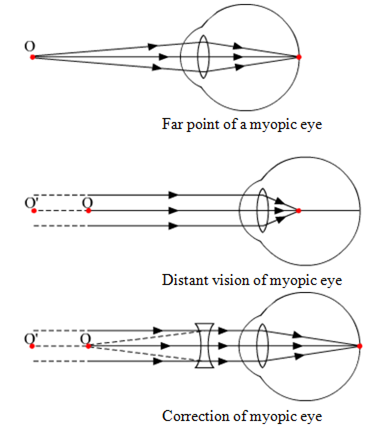
a)
The function of:
Cornea: When light enters the eye, most of the refraction occurs at the surface of cornea.
Iris: It is a dark, muscular diaphragm that controls the size of the pupil.
Crystalline lens: Helps in the finer adjustment of the focal length required to focus objects at different distances on the retina.
Ciliary muscles: The lens becomes thin when ciliary muscles are relaxed thereby, increasing its focal length. Thus, we are able to see the distant object clearly. The ciliary muscles contract, when we are viewing objects nearby, increasing the curvature of the eye lens. Therefore, the eye lens becomes thicker and focal length decreases. This makes it easier to see the nearby objects clearly.
b)
i) The objective of such organisation is to light up the life of a blind person by donating eyes. the objective statement will be, 'Enlighten the life of Blind'.
ii) The arguments are:
1. We have enjoyed our life by seeing the beauty of nature. Then why not give the same pleasure to the blind. Pass on your gift of vision to the needy and do a charitable deed.
2. Age group of a person or sex does not matter when it comes to donating eyes. If a person uses spectacles or underwent surgery for cataract, can also donate eyes. A person suffering from any kind of communicable disease cannot donate eyes.
iii) Social welfare, awareness, charitability are some of the values that is developed in a person who actively participate and contribute to such programs.
What is atmospheric refraction? Use this phenomenon to explain the following natural events:
a) Twinkling of stars
b) Advanced sunrise and delayed sunset
Draw diagrams to illustrate your answer.
Atmospheric refraction is the refraction of light caused by the earth's atmosphere due to change in the refractive indices of different layers of the atmosphere.
a) Twinkling of stars: Stars are distant point sourced sources of light. The path of the rays of light comig f=coming from the distant star goes on varying due to atmospheric refraction slightly. Thus, apparent position of the star fluctuates and the amount of star light entering the eye flickers giving the twinkling effect.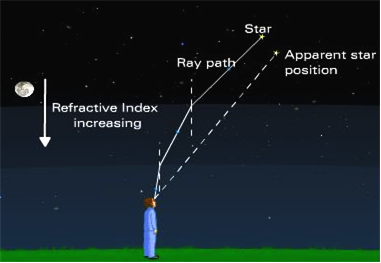
b) Advanced sunrise: When the sun is slightly below the horizon, light rays coming from the sun travel from rarer to denser layers of air. As a result of the atmospheric refraction of light. light appears to come from a higher position above the horizon. Therefore, the sun appears earlier than actual sunrise.
Delayed sunset: During sunset, the apparent position of the sun is visible to us and not the actual position due to the same bending of light rays effect. Therefore, because of refraction, we see the sunset afterwards although it has actually moved from its position.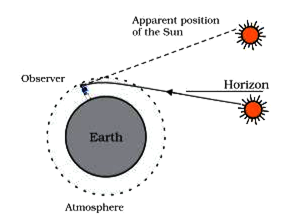
(a) A person cannot read newspaper placed nearer than 50 cm from his eyes. Name the defect of vision he is suffering from. Draw a ray diagram to illustrate this defect. List its two possible causes. Draw a ray diagram to show how this defect may be corrected using a lens of appropriate focal length.
(b) We see advertisements for eye donation on television or in newspapers. Write the importance of such advertisements.
(a) If a person cannot read newspaper placed nearby, the person is suffering from hypermetropia i.e. far-sightedness. The person is unable to see the nearby objects distinctly and can only see far-by objects with a clear vision. The diagram below illustrates this defect: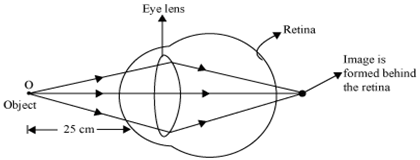
The two possible causes of hypermetropia are:
(i) The focal length of the eye lens is too long
(ii) Decrease in the length of the eyeball
By using convex lens of appropriate focal-length, this defect can be corrected. 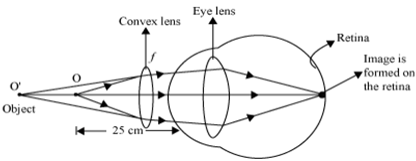
(b) Our eye can live even after our death. By donating our eyes, we can give vision to any blind person so that he/she can see the wonderful beauty of this world. By advertising about eye donations, we can make more people aware of this noble cause and help more blind people around us.
